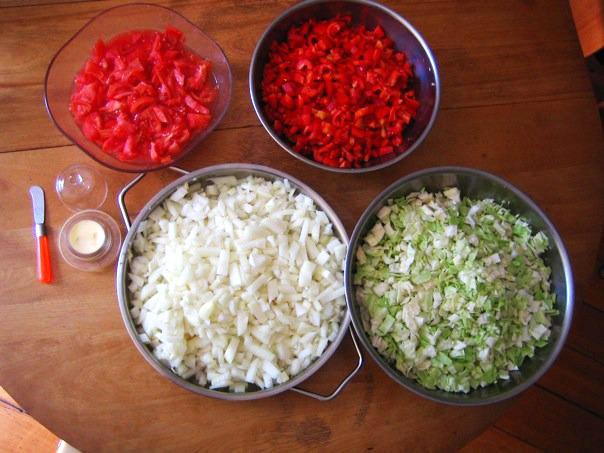Out of all the many foods my mother made, Paprekash is the one that brings her memory flooding back. The ritual of preparing it, the patient waiting while it cooks, the taste, the smell: every fall I have to make a batch of this Ukrainian dish, which is meant to take advantage of the abundance of ripe tomatoes and peppers available then. When you’re at the farmers’ market and the stalls are selling tomatoes and peppers by the bushel? That’s when you make Paprekash.
My food writer pal Marion Kane heard me talk about this dish and, as Marion is wont to do, she got curious. She and I made it one day in her kitchen as she decided to write a story about it for her food column in the Toronto Star; that story appeared on March 23, 2006 but the article is behind a paywall, now.
If you look up the name “Paprekash” online, your search engine will primly correct it to “Paprikash” and toss up dozens of Hungarian chicken stew recipes. Marion described the dish — sautéed onions mixed with chopped cabbage, peppers, and tomatoes, and roasted for a long time — to other Ukrainian cooks she knew and they declared the right name was “kapusta” (also the name for cabbage) or “salata”. A couple years after that, I was at a reception hosted by Myroslaw Tataryn and his wife, Maria, Myroslaw being a Ukrainian Catholic priest and academic and Maria also Ukrainian and an academic. I described my mother’s dish without name to Maria and she said, “oh yes! Paprekash!”
This vegetable side dish pairs well with any kind of mash, the potatoes soaking up some of the juice. Round that out with a protein such as roasted pork, chicken or grilled sausages. It freezes well: some years I make this for a Thanksgiving dinner, then package up a portion for the freezer to bring out and reheat for a Christmas or other winter holiday feast.
Paprekash
8 large tomatoes
2 tbsp butter
1 tbsp vegetable oil
6 large onions, peeled, coarsely chopped
1 tsp kosher or coarse sea salt
½ tsp freshly ground black pepper
1 green cabbage, cored, shredded or coarsely chopped
6 large bell peppers (all red or a combo of red, orange and yellow), stems and seeds removed, coarsely chopped
Salt and pepper to taste
Preheat oven to 325 degrees.
Cut an “X” in stem end of each tomato. Bring large saucepan of water to boil over high heat. Add tomatoes; return water to boil and cook about 30 seconds or until skin begins to loosen. Transfer to plate; cool a few minutes. Peel off and discard skin; chop tomatoes coarsely.

In very large skillet, heat butter and oil over medium heat. Add onions; sprinkle with salt and pepper. Cook, stirring, until golden brown, at least 15 minutes. (There are a lot of onions and this takes longer than you might expect. Don’t turn the heat to “high” because the onions will scorch too much. You are going for “limpid golden”.)
Transfer onions to bottom of large roasting pan or divide into two medium pans.
Over the onions, layer the cabbage, peppers and tomatoes. Cover with foil or lid.
Cook 2 to 2½ hours, stirring mid-way through, or until onions are golden and caramelized and the mixture has a rich colour. Add salt and pepper to taste. Note that cooking time varies widely with the kind of pan you use. If there is any green tinge at all to the cabbage, it’s not cooked enough. It needs to be caramel-coloured. Be patient.
Makes 10 to 12 servings. Enjoy some right away and freeze the rest in serving sizes.
Main photo: Kelley Teahen